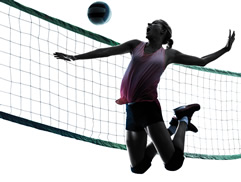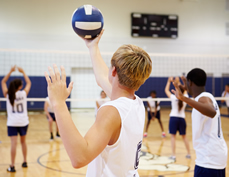
Sports Vision Training consists of the learning and training of Dynamic Visual Skills – that is “Vision in Motion”. These skills include Accommodation and Convergence, Anticipation Timing, Concentration under Stress, Depth Perception, Eye-Hand Coordination, Peripheral Awareness, Speed and Span of Recognition and Visual Reaction Time. (For more in-depth explanations, see the attached Visual Skills definition sheet.) These are all learned skills that can be improved with practice.
The following is an explanation of the most relevant dynamic visual skills associated with volleyball.

The amount of time it takes a player to recognize a play and react to it, by adjusting his/her body position, can be crucial. Opportunities to return a spiked ball, which can be travelling at over 70mph, only present themselves for a fraction of a second. Absorbing as much information as possible will enable players to anticipate all possible play developments and therefore foil any surprising tactic or play.
Depth perception allows us to judge the distance, the speed and the revolution of objects in space. Necessary for accurate serving, setting and boundary line play or no play determination.
Eye tracking ability is important since quick, accurate saccades (or eye movements), are needed to rapidly survey the locations and movements of the other eleven players and the ball, in relationship to the net, boundary lines, etc.
Since the ball and other players move quickly, it is necessary to shift focus from near to far or intermediate targets rapidly throughout the match.
The visual system leads the motor system. Our hands or feet or body respond to the information the eyes have sent to the brain. If the information is incorrect, even to the slightest degree, there is a good chance that we will err in our physical response. In volleyball, this skill becomes one of the most important, when serving, passing, setting, bumping, blocking, diving or spiking.
Secondary dynamic visual skills used in volleyball are Visual Reaction Time, Concentration, Eye Fatigue, Peripheral Awareness, and Visualization.